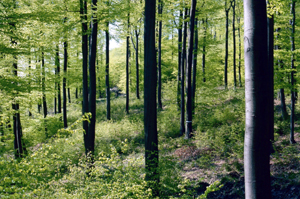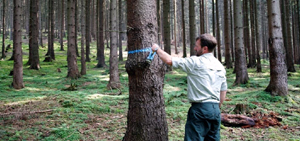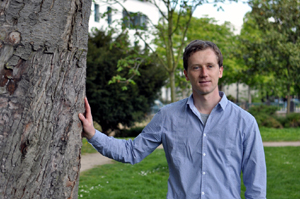These days Germany remembers that the concept of sustainability was originally developed in the timber industry. Wood is an important natural resource and a means for carbon dioxide storage. A new study shows that wood consumption contributes substantially to climate protection in North Rhine-Westphalia.

The Food and Agriculture Organization (FAO) predicts that by the year 2050 the world wood consumption could increase up to 50 percent due to the rising global population and increasing demand, in particular from emerging countries. Meanwhile 5.2 million hectares of forest are lost every year. That equals a football field per second. Forests are being cut down faster than they can grow.
Father of sustainability
300 years ago, Hans Carl von Carlowitz, a Saxe nobleman and royal mining administrator, realized that this, in the long run, would destroy the livelihood of the local population. Back in the early 18th century, people in Saxony not only relied on wood for cooking, heating and building, but the local silver mining and smelting of ores consumed whole forests. Worried about the increased wood scarcity, he championed a system of cultivation of timber so “that there would be a continuous, steady and sustained use“.
Carlowitz is considered to be the father of the principle of sustainability. Last week’s national awareness week for sustainability (June 15 – 21) focused on the 1713 publication of his groundbreaking book („Sylvicultura Oeconomica“) on sustainable yield forestry. For the opening of a travelling exhibition dedicated to his life and work, the forestry office in Siegen-Wittgenstein organized a one-day conference on „sustainability over the course of time“.
The term nowadays has a much wider scope, Alrogge says: “In addition to the economic component, we are now looking at the ecological, social and cultural value.” The goal is a sustainable, multi-functional management that balances the economic, ecological and recreational aspects of forests.
Sustainability has a long tradition in the Siegerland going back to the Middle Ages, says Altrogge. An energy crisis caused by timber scarcity required a radical re-thinking. Siegen-Wittgenstein is today not only the best wooded county (70%) in the whole of Germany, but also its third strongest industrial region. „The Siegerland was a famous centre of weaponry in Central Europe while the Ruhr valley (Germany’s biggest industrial area) was still sleeping under a thick beech tree cover. Half of the knight amours came from our region,” he explains.
The flourishing medieval steel mills led to a rapid increase in population and almost complete deforestation. Altrogge cites the 1562 forest and wood ordinance born out of acute wood scarcity. Among others, it implemented that each homeowner shall plant as many trees annually as the cattle he owns and that for each tree cut for construction material four oak trees must be replanted.
New wood age

Early in May State Minister of the Environment, Johannes Remmel presented the results of a study on forestry and climate change mitigation in North Rhine-Westphalia (NRW). “The new study proves that, in addition to the carbon sink, forest wood products serve as durable carbon stores. It also shows that the substitution capacity of wood is vital for climate protection in NRW”, he concluded.
According to the study, sustainably managed forests and forest products are reducing CO2 emissions in North Rhine-Westphalia by about 18 million tons annually. 22 percent are caused by the sink effect of the forest and 78 percent by the use of wood. Thus, not the forest itself, but the actual utilization of the renewable natural resource is the most effective way to mitigate climate change.
Wood instead of plastic
The increased use of wood-based products as a substitute for plastics, metals or concrete and a better cascading use, would further improve the CO2 balance. Cascading involves timber and paper recycling and the energy use of wood (as a substitute for fossil fuels) at the end of its life-span, in order to extend the carbon storage.
For Altrogge wood is by far the most environmentally friendly material that nature provides because the production and processing is highly energy efficient. “Forests breathe in carbon dioxide and release oxygen. So wood burning is carbon-neutral. Each wooden rail tie is better than a concrete one,” he adds. Altrogge refers to a new wind energy plant in Northern Germany whose 100-meter tall tower is entirely manufactured out of wood. This timber tower made from 100 spruce trees, he says, shows that wood can be a low-cost alternative to steel and an important component of Germany’s energy transformation.
The forestry and woodworking industry provides employment to 180,000 people in North Rhine-Westphalia, generating € 38 billion in annual revenue (2011) that is about the size of mechanical engineering industry. Seventy percent of the forest land in NRW is privately owned. Forests are a stable asset, currently delivering 3.5 to 5 percent in annual return, according to Alrogge.
Sustainable forestry is considered a hedge against inflation because of its finite supply and inherent organic growth. As trees get larger, their value increases. But forest investors have to be patient. In Germany’s temperate climate, it takes 50 to 80 years from the planting of a seedling to the harvest of a full-size tree. In moist tropical climates, trees grow much faster, which cuts the waiting period down to about 25 years.
EU bans illegally cut wood imports
The EU Timber Regulation (EUTR), which came into effect in March, prevents illegally harvested timber and derived wood products from entering EU markets. This new regulatory measure, which was initiated due to concerns about unsustainable forest management practices and illegal logging, will increase the demand for certified tropical wood.
In developing and emerging countries, sustainable forest management can be a means to reduce poverty and land degradation. There are good examples of participatory forestry and community based enterprises that enable communities to balance their economic needs with environmental conservation. In developed countries, on the other hand, there is a growing interest in social impact and sustainable forest investments. However, the forest area must be large enough to be internationally profitable and cost-effective.
Drones against illegal logging

This is not about charity, he says, but ecological impact investments that provide stable long-term returns, in addition to carbon offset credits. Social and cultural aspects are important as well. It should be a beneficial collaboration for both sides — the foreign investor and local project partner.
Watson is not concerned that the timber market will crash, but there are other risk factors such as pests, forest fire, windfall and illegal logging. He and his partners are using unmanned aircraft and modern technology to assess risk, gather information and increase security.
“We want to build trust through transparency,” says the 30-year old entrepreneur. “We are using drones for the production of high resolution orthographic maps and 3-D models to evaluate project implementation and forest health.”
Repeated aerial surveys assist in monitoring illegal activities and detecting damages at an early stage. “The drones are transmitting extreme high resolution images, much better than satellites. We can even see single tree branches,” Watson adds.
Following in the footsteps of Hans Carl von Carlowitz, this can be said to be sustainable forestry management 2.0.
Useful Links:
FAO forest info graphic http://www.fao.org/economic/es-home/infographics/forest-info/en/#.UcKVeu86nIU
Study Forest and Climate Protection in NRW (in German)
http://www.wald-und-holz.nrw.de/wald-und-holz-nrw/aktuelles-und-presse/aktuelle-meldung/pm/klimapositives-wachstum-in-der-forst-und-holzwirtschaft-ist-das-moeglich.html
Timber Tower http://www.timbertower.de/en/
Openforests http://www.openforests.com/
Openforests drone video demo http://demos.openforests.com/videos/forest-damage-assessment.html?width=854&height=480&iframe=true&scrolling=false&template=node_in_colorbox
